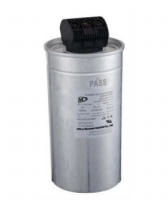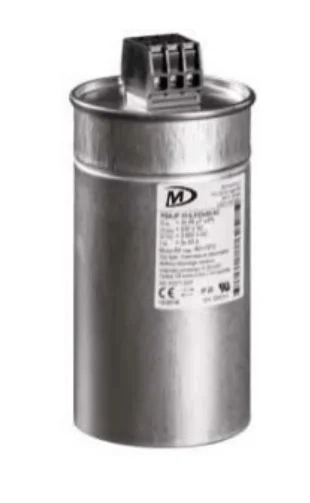An AC-to-DC filter circuit is vital for changing alternating current (AC) into direct current (DC). It keeps voltage ripple low and ensures steady performance. The success of these circuits depends on choosing and combining components carefully. Their ability to manage electrical properties well is also important.
The main parts of an AC-to-DC filter circuit are capacitors, inductors, and resistors. Capacitors store and release energy. They smooth out voltage changes and reduce ripple. Inductors block high-frequency noise. They achieve this by impeding abrupt changes in current. Resistors control current flow. They also keep the circuit stable to avoid overheating or damage.
AC filter capacitors are used for AC filtering and high-frequency harmonic processing. They often use a metalized polypropylene film as the core material. An aluminum shell package makes them durable. These capacitors include built-in overpressure cut-off protection devices for safety.
Capacitors are key in filtering. They smooth the rectified DC output. They charge during voltage peaks. They discharge during voltage dips. This reduces voltage ripple. As a result, the DC output is steady. This is suitable for sensitive electronics. Modern AC filter capacitors have good heat dissipation. They are lightweight and small in size. These advantages are significant for industrial applications.
Voltage ripple is the leftover variation in DC voltage after rectification. Too much ripple can cause issues. It may make electronic parts work poorly. It can also lead to overheating or failure. Using effective filtering parts, like low-ESR (Equivalent Series Resistance) capacitors, keeps ripple low. This boosts circuit reliability.
Picking the right capacitors greatly affects circuit performance and lifespan. The correct type ensures good energy storage. It also manages heat well and meets specific voltage needs.

Different capacitors serve various purposes:
1. Electrolytic Capacitors: These are great for high-capacitance needs. But they may have higher ESR.
2. Film Capacitors: They are stable with low ESR. They work well for high-frequency filtering.
3. Ceramic Capacitors: These are small. They perform well in high-frequency tasks.
4. AC filter capacitors: These are made for reactive power compensation and harmonic suppression.
The capacitance value decides how much charge a capacitor can hold. This affects its ability to smooth voltage ripples. The voltage rating must be higher than the maximum operating voltage. This prevents breakdown or failure.
Low ESR is important for efficient energy transfer. It also reduces heat buildup. Modern AC filter capacitors have double protection. They include secondary safety devices. This ensures durability in different electrical conditions.
Buck converters are step-down regulators. They change higher input voltages to lower output voltages efficiently. High-quality capacitors are essential for their performance.
Buck converters work by switching transistors on and off quickly. Inductors and capacitors smooth the output current. These devices are common in power supply systems. They reduce energy loss during voltage changes.
Low ESR capacitors are vital for buck converters. They reduce heat during high-frequency tasks. They also keep output voltages steady. Capacitor technologies, like metalized polypropylene film, ensure reliable performance under changing loads. This makes them necessary for applications needing precise power control.
By understanding these ideas, engineers can build strong AC to DC filter circuits. These circuits can meet specific needs. They ensure efficiency, safety, and long life in many applications.
SMILER's buck converter capacitors are designed to excel at minimizing voltage ripple. This is important for steady and efficient circuit performance. These capacitors use advanced materials. They include metalized polypropylene film. This material is known for its strong dielectric properties. It also stays stable in various electrical conditions. AC filter capacitors are used for AC filtering and high-frequency harmonic processing. By using this technology, SMILER ensures their capacitors reduce voltage fluctuations well. This provides a steady DC output. This is needed for sensitive electronic devices.
The low Equivalent Series Resistance (ESR) of these capacitors improves their efficiency. Low ESR reduces energy losses during charging and discharging. It also lowers heat buildup. This enhances overall performance. These capacitors are ideal for high-frequency applications. Examples include buck converters, where fast switching happens.

SMILER's buck converter capacitors are built to last. Their strong construction includes an aluminum shell package. They also have oil-filled internal potting. These features provide excellent heat dissipation. They also offer mechanical stability. Good heat dissipation, lightweight, and compact size are clear benefits of modern AC filter capacitors. These traits allow the capacitors to handle high temperatures. They also withstand electrical stress. They maintain performance over time.
SMILER includes double protection systems in their designs. These include secondary protection devices. They also have built-in overpressure cut-off systems. These protect against failures from overvoltage or excessive current. Modern AC filter capacitors provide double protection with secondary protection devices. This reliability makes them suitable for demanding applications. Consistent operation is critical in these settings.
SMILER's capacitors are widely used in AC to DC circuits. They perform well in reactive power compensation. This ensures efficient energy transfer in power systems. Reactive power compensation keeps the voltage stable across electrical networks.
These capacitors are also important in energy storage equipment. They are used in low-voltage parallel circuits. Their ability to manage high-frequency harmonic processing is key. They are vital in applications like variable frequency drives (VFDs). They also work in other dynamic load systems. Components for Passive Power Factor Correction <1000 V AC For the low voltage level, including long-life reactive current capacitors, contribute significantly to reliable static as well as dynamic power regulation.
By using SMILER's advanced capacitor technologies, engineers can achieve great circuit performance. These capacitors reduce energy losses. They also extend the life of electronic components.
For an AC to DC-filter circuit to work well, all parts must function together smoothly. Capacitors, inductors, and resistors need to be compatible. Their specifications should match the circuit's needs. For example, choosing a capacitor with the right capacitance and voltage rating is crucial. This ensures the circuit runs efficiently. It also prevents overloading any component.
Environmental conditions impact capacitor performance. Temperature, humidity, and vibration can affect durability. SMILER's capacitors are designed to handle these challenges. Their aluminum shell and oil-filled potting improve heat dissipation. This makes them suitable for tough settings. Examples include industrial sites or outdoor renewable energy systems.
Recent improvements in capacitor technology have enhanced AC to DC filter circuits. Metalized polypropylene film capacitors are more stable than older materials. They have lower ESR. This reduces energy losses. Self-healing properties in these capacitors prevent failure from small faults. This extends their lifespan. It also improves reliability.
Safety is a major concern in capacitor design. SMILER's capacitors meet strict safety standards. Their UL94 V-0 resin filling provides flame resistance. Overpressure cut-off devices protect against electrical surges. These features ensure safe operation. This is important for critical applications, like medical equipment or industrial machinery.
Quality control is vital for reliable capacitors. SMILER uses thorough testing. Each capacitor is checked for capacitance, ESR, and voltage tolerance. This ensures they meet industry standards. Consistent quality control lowers the risk of circuit failures. It also builds trust in SMILER's products.
Modern power systems need efficient components. SMILER's capacitors work well with advanced systems. Examples include renewable energy setups or smart grids. Their ability to handle high-frequency harmonics makes them ideal for dynamic loads. They also support energy-efficient designs. This reduces overall power use.
High-quality capacitors, like SMILER's, offer long-term savings. Their durability reduces the need for replacements. Low ESR minimizes energy losses. This lowers operating costs. These factors make them a smart choice for industries balancing performance and budget.
The future of AC to DC filter circuits involves smarter designs. Innovations like smart capacitors with sensors are emerging. These can monitor performance in real-time. They predict maintenance needs. SMILER is exploring these technologies. This keeps their capacitors relevant in growing industries.
By considering these factors, engineers can use SMILER's capacitors to design reliable AC to DC filter circuits. These circuits meet the needs of modern applications. They ensure strong performance and long-term durability in fields like industrial machinery and renewable energy systems.
Q: What makes SMILER's buck converter capacitors unique?
A: SMILER's buck converter capacitors stand out due to their high efficiency in reducing voltage ripple. They have durable aluminum shells. They feature oil-filled internal potting for heat dissipation. They also include advanced safety mechanisms like overpressure cut-off devices.
Q: How do these capacitors improve circuit performance?
A: These capacitors enhance circuit performance by minimizing voltage ripple with low ESR design. They ensure a steady DC output for sensitive electronics. Their strong safety features also improve reliability.
Q: Can SMILER's capacitors handle high-frequency operations?
A: Yes, SMILER's capacitors are designed for high-frequency tasks. Examples include buck converters and variable frequency drives. Their low ESR ensures minimal energy loss during fast switching.
Q: Where are these capacitors commonly used?
A: SMILER's capacitors are used in AC to DC filter circuits. They handle reactive power compensation, energy storage systems, low-voltage parallel circuits, and harmonic suppression tasks.
Q: Why is durability important in capacitor design?
A: Durability ensures capacitors can endure electrical stress and environmental factors. This maintains performance and reliability over long periods. This is key for critical applications needing consistent operation.